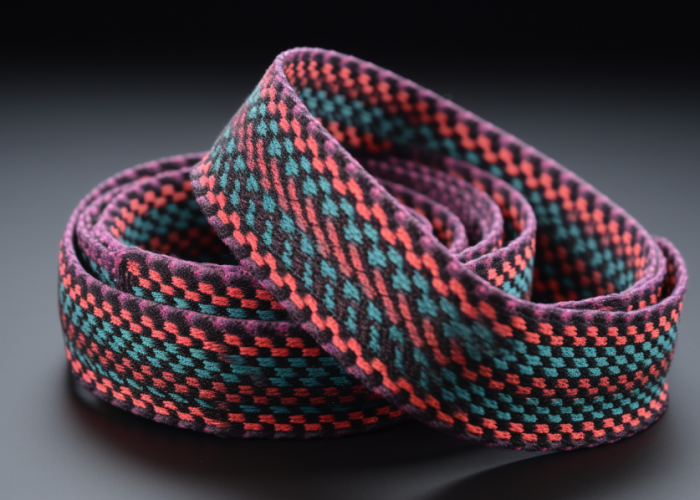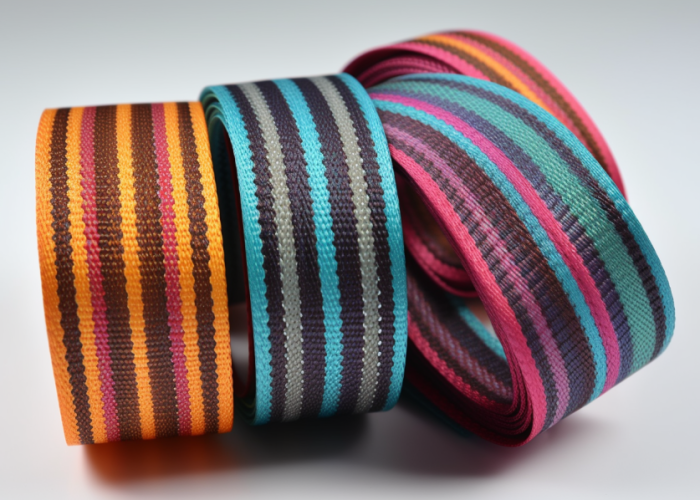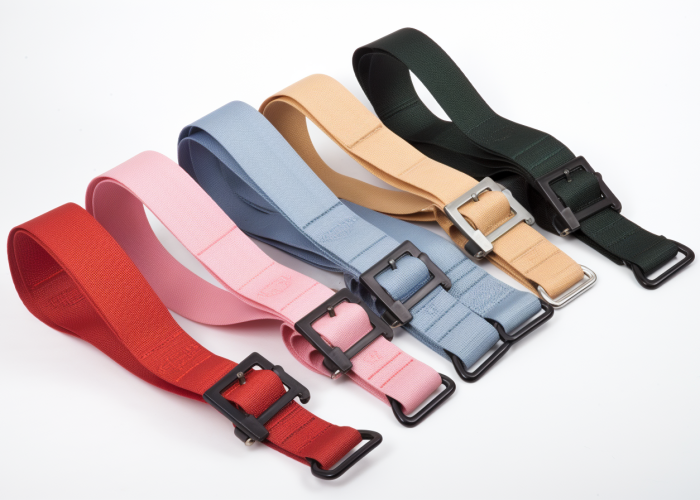Selecting the right webbing pattern for body straps critically impacts product safety, performance, and longevity. As custom webbing manufacturers, we help engineers balance aesthetic needs with structural requirements for optimal application-specific solutions.
Plain weave offers superior durability for body straps compared to jacquard weaving, with 20-30% higher strength retention in high-stress applications. This advantage comes from plain weave’s simple pattern that maximizes yarn density and distributes tension evenly across the entire width.
Explore webbing pattern performance, real-world applications, and selection tips to help you choose the best webbing for your product needs.


Webbing manufacturing expert with 15+ years of experience helping product developers build high-performance straps for industrial, medical, and outdoor use.
Plain weave provides 20-30% higher durability for body straps compared to jacquard due to its simple over-under pattern that maximizes yarn density and distributes tension evenly across the entire width. This structural advantage creates consistently stronger webbing for safety-critical applications like climbing harnesses, automotive restraints, and load-bearing backpack straps where reliability cannot be compromised.
Key durability advantages of plain weave:
The manufacturing process for plain weave contributes significantly to its durability advantage. The uniform interlacing creates a consistent physical barrier against abrasion commonly experienced in body-contact applications like tactical gear and industrial safety harnesses.
Dynamic loading tests, simulating real-world usage patterns in accordance with EN ISO 13934-2 standards, show jacquard patterns experiencing yarn displacement much earlier than plain weave. For product developers, this translates to more predictable performance and longer service life, particularly important for products requiring UL or CE certification.
For engineers designing body-supporting products subject to ANSI Z359 (fall protection) or similar safety standards, plain weave’s controlled elasticity ensures that load-bearing calculations remain reliable throughout the product’s service life, reducing required safety factors in design specifications.
From a production standpoint, plain weave offers better value in applications where visual aesthetics are secondary to performance requirements. This cost advantage can be significant for high-volume production while maintaining superior safety characteristics.
The interaction between fiber material and weave pattern creates a multiplicative effect on webbing performance, with high-tenacity nylon in plain weave offering up to 40% higher load capacity than the same material in jacquard patterns. This material-weave relationship significantly impacts durability, flexibility, and environmental resistance across different applications.
Key material-weave interactions:
The base material significantly amplifies or diminishes a weave pattern’s inherent properties. High-tenacity polyamide (nylon) fibers with plain weave create the strongest possible combination for critical load-bearing, while the same fibers in twill weave excel in applications requiring shock absorption like climbing equipment.
Material selection becomes particularly critical when considering environmental exposure. Polyester webbing maintains 92-95% of its strength when wet, regardless of weave pattern, while nylon can experience 15-20% strength reduction in wet conditions. For outdoor applications, this material property often outweighs weave structure considerations.
For product developers requiring customized performance profiles, strategic material-weave combinations can provide targeted solutions. Hybrid constructions using different materials in warp and weft can combine the beneficial properties of multiple fiber types while maintaining manufacturing efficiency.

Each webbing pattern excels in specific real-world applications based on their performance characteristics, with plain weave dominating safety-critical applications while jacquard and twill serve specialized needs in other sectors. Understanding these application-specific advantages helps product developers select the optimal webbing for their requirements.
Best applications by pattern:
In safety-critical applications, plain weave dominates due to its predictable performance characteristics. Fall protection equipment manufacturers consistently specify plain weave for harness components that must meet ANSI Z359.1 certification, as its failure modes are well-understood and can be engineered with appropriate safety factors.
Consumer goods frequently employ jacquard patterns when brand identity and aesthetics are prioritized. Camera straps, luggage webbing, and consumer-grade outdoor equipment often use jacquard patterns with reinforced edges to balance visual appeal with adequate performance.
For applications requiring energy absorption, twill weave patterns provide an ideal balance. Automotive seatbelts exclusively use twill weave due to its controlled elongation under impact forces, providing optimal passenger restraint while minimizing injury risk.
Specialized industries often require custom solutions that combine elements of multiple patterns. Military equipment frequently uses proprietary weave variations that enhance specific performance aspects, while aerospace applications demand specialized patterns certified to stringent industry standards.
Plain weave’s simple over-under structure creates the most effective load distribution system for webbing, with stress forces spreading across 100% of available fibers compared to 75-85% utilization in complex patterns. This complete fiber engagement is why plain weave remains the industry standard for safety-critical applications.
Plain weave structural advantages:
The regular interlacing pattern in plain weave creates a structure where forces travel along predictable paths, allowing engineers to calculate load distribution with high precision. This predictability is crucial for applications where safety factors must be accurately determined.
In dynamic loading situations, plain weave demonstrates superior performance in maintaining structural integrity. Impact testing shows plain weave distributes sudden forces across its entire width within 8-12 milliseconds, compared to 15-25 milliseconds for complex patterns – a critical difference in fall arrest scenarios.
Edge stability represents another significant advantage in safety applications. Plain weave’s structure naturally resists raveling when cut or abraded, maintaining structural integrity even when damaged. Testing shows plain weave retains 85-90% of its strength even with 10% edge damage, compared to 60-70% retention in jacquard patterns.
For product developers requiring certification to safety standards, plain weave’s consistent performance simplifies the testing and documentation process. The lower variance in breaking strength (typically ±5% compared to ±15% for complex patterns) ensures more reliable minimum strength guarantees.
Jacquard weaving becomes the preferred choice for body applications when visual differentiation, brand identity, and moderate load requirements converge, offering 90-95% of plain weave’s strength while providing unlimited design possibilities. Understanding when to select jacquard patterns helps balance aesthetic needs with performance requirements.
When jacquard is appropriate:
For consumer products where brand recognition drives purchase decisions, jacquard patterns offer significant marketing advantages. Premium camera straps, luggage webbing, and fashion accessories benefit from distinctive patterns that communicate brand identity while maintaining adequate performance.
Jacquard webbing excels in applications requiring moderate load capacity combined with enhanced user experience. The texture variations possible with jacquard can improve grip, reduce slippage against clothing, and create strategic zones of flexibility that enhance comfort in body-contact applications.
Tactile differentiation represents another advantage in specialized settings. Industrial equipment often uses jacquard patterns to create distinct textures for different functions, allowing users to identify appropriate attachment points by feel – a crucial feature in low-visibility environments.
Product developers can strategically reinforce jacquard webbing in high-stress areas while maintaining decorative elements elsewhere. This hybridized approach allows for visual customization without compromising essential performance characteristics in critical load paths.

Different weaving techniques present distinct cost-performance profiles, with plain weave offering the best strength-to-cost ratio while jacquard commands a 15-25% price premium for its customization capabilities. Understanding these economic factors helps product developers optimize both performance and manufacturing costs.
Cost-performance factors:
The manufacturing complexity of different weave patterns significantly impacts production economics. Plain weave’s simpler structure allows for faster loom speeds (typically 20-30% higher production rates) and quicker setup times, reducing labor costs and improving manufacturing efficiency.
For product developers facing budget constraints, understanding these cost drivers helps identify value engineering opportunities. Strategic use of jacquard elements only where visible or functionally necessary can reduce costs while maintaining brand identity and performance where required.
Production volume represents a critical factor in pattern selection economics. For high-volume applications (5,000+ meters), the setup costs of jacquard patterns become less significant, making customization more economically viable. Conversely, for smaller production runs, the setup overhead makes plain weave more cost-effective.
Material waste varies significantly between patterns, with complex jacquard designs typically generating 5-10% more waste during manufacturing. This factor becomes increasingly important when using premium or specialty fibers where raw material costs represent a larger percentage of total production expense.
When evaluating lifetime costs, the superior durability of plain weave often offsets its lower aesthetic value. In applications where replacement frequency impacts overall economics, plain weave’s extended service life can reduce lifetime costs despite potentially lacking the visual appeal of decorative alternatives.
Twill weave offers a middle ground between plain and jacquard patterns, providing 85-90% of plain weave’s strength with 30-45% greater flexibility and moderate design options. This unique performance profile makes twill ideal for specific body strap applications requiring controlled energy absorption.
Twill weave characteristics:
The distinctive diagonal structure of twill creates inherent directionality in performance properties. This controlled anisotropy allows product developers to engineer straps with different characteristics in length versus width – particularly valuable for applications requiring specific elongation profiles.
Twill weave excels in applications requiring energy absorption and impact mitigation. Automotive seatbelts exclusively utilize twill weave due to its progressive elongation under impact forces, which reduces peak loads transmitted to the body while maintaining adequate restraint.
For body-conforming applications like backpack straps, medical braces, and ergonomic supports, twill’s superior flexibility creates better anatomical conformity and comfort. The pattern allows 15-25% better drape around complex body contours while maintaining load capacity and durability.
Abrasion resistance represents another significant advantage of twill construction. The diagonal structure naturally distributes surface wear across multiple fibers, resulting in 15-20% greater cycle counts in standardized abrasion testing (ASTM D4158) compared to plain weave of identical materials.
Product developers can utilize twill’s moderate customization options to create subtle branding elements without the significant strength compromise of full jacquard patterns. This balance makes twill popular for premium products where both performance and aesthetics are important considerations.
Environmental exposure affects webbing patterns differently, with plain weave showing 30-40% better resistance to UV degradation and moisture effects compared to complex patterns due to its more protected fiber structure. Understanding these environmental interactions helps product developers select appropriate webbing for specific usage conditions.
Environmental durability factors:
Ultraviolet radiation represents one of the most significant degradation factors for outdoor webbing applications. Testing shows plain weave structures retain 15-20% more tensile strength after equivalent UV exposure compared to jacquard patterns, primarily because complex patterns create more exposed fiber surfaces vulnerable to photodegradation.
Moisture interactions vary significantly between weave patterns. Complex jacquard structures typically show 10-15% higher water absorption rates, leading to greater weight increase when wet and longer drying times. This characteristic becomes particularly important in marine or high-humidity environments.
Temperature extremes affect pattern durability differently. In cold conditions (-20°C/0°F), complex patterns experience greater stiffening and potential brittleness due to varied tension across fibers. At high temperatures (80°C/175°F), jacquard patterns show earlier onset of strength degradation compared to plain weave of identical materials.
For chemical exposure scenarios, pattern simplicity generally correlates with improved resistance. Plain weave’s uniform structure minimizes exposed fiber surface area and reduces penetration of contaminants into the webbing structure, resulting in better retention of properties when exposed to common chemicals like petroleum products, cleaning agents, and industrial fluids.
Environmental cycling (alternating wet/dry or hot/cold conditions) particularly impacts complex patterns due to differential expansion and contraction stresses. Accelerated weathering tests (ASTM G154) show plain weave retaining 25-35% more original strength after equivalent environmental cycling compared to decorative patterns.
Material Weave Pattern Strength & Load Durability (UV, Moisture, Abrasion) Flexibility & Comfort Cost Efficiency Best Applications
Polyester Plain Weave ★★★★☆ (Strong, stable) ★★★★★ (Best outdoor life) ★★★☆☆ (Stiff but stable) ★★★★★ (Most cost-effective) Safety straps, fall protection, marine rigging
Polyester Jacquard ★★★☆☆ (Moderate) ★★★☆☆ (Good, but lower UV resistance) ★★★★☆ (Enhanced comfort) ★★☆☆☆ (Higher cost) Branded outdoor gear, luggage, camera straps
Nylon (PA) Plain Weave ★★★★★ (Best tensile strength) ★★★☆☆ (UV-sensitive, absorbs moisture) ★★★☆☆ (Moderate comfort) ★★★★☆ (Cost-effective for safety) Dynamic load straps, fall protection, tow straps
Nylon (PA) Twill ★★★★☆ (Slightly lower than plain weave) ★★★☆☆ (Same UV sensitivity) ★★★★★ (Best flexibility & shock absorption) ★★★☆☆ (Moderate cost) Seatbelts, climbing harnesses, comfort-focused wearables
Polypropylene Plain Weave ★★☆☆☆ (Low strength) ★★★★☆ (Best in water, buoyant) ★★★☆☆ (Basic) ★★★★★ (Low cost) Dock lines, marine floating gear, fishing equipment
Hybrid (e.g., Nylon core, Polyester sheath) Spiral/Twill/Composite ★★★★★ (Customized extreme strength) ★★★★★ (Tailored for UV, salt, etc.) ★★★★☆ (Flexible with comfort zones) ★☆☆☆☆ (High cost, specialized) Aerospace, high-end racing gear, premium military
Plain weave offers superior strength for safety-critical applications, while jacquard provides visual distinction where moderate loads are expected. Select the appropriate pattern based on your specific performance requirements, safety standards, and brand identity needs. Contact us to explore manufacturing solutions tailored to your product requirements.
Plain weave generally achieves 20-30% higher cycle counts in standardized abrasion testing, while twill weave demonstrates 15-20% better surface abrasion resistance. Jacquard patterns show more variable results depending on specific design complexity, with simpler patterns performing significantly better than intricate designs.
Yes, jacquard patterns can be reinforced through strategic fiber selection and hybrid construction techniques. Reinforced edges, specialized high-tenacity yarns, and selective doubling of load-bearing sections can improve jacquard strength by 30-40% while maintaining decorative elements in non-critical areas.
Material selection can amplify or mitigate pattern-related strength differences by 15-40%. High-tenacity nylon with plain weave creates maximum strength for critical applications, while polyester better preserves jacquard definition while providing superior UV and moisture resistance for outdoor use.
Jacquard webbing typically costs 15-25% more than plain weave due to slower production speeds and more complex setup requirements. This premium decreases with larger production volumes (5,000+ meters) as setup costs are distributed across more units, making customization more economical at scale.
Simpler patterns like plain weave offer 5-10% better material efficiency and energy consumption during manufacturing. Additionally, their superior durability extends product lifespans, reducing replacement frequency and overall environmental impact throughout the product lifecycle.
Key safety standards include ANSI Z359.1 for fall protection, FMVSS 209 for automotive restraints, and EN 12195-2 for load securing applications. These standards specify minimum breaking strength, elongation limits, and abrasion resistance requirements that influence appropriate webbing pattern selection.